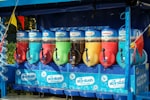Nothing in the NHL is ever simple, and no one ever remembers all the ins and outs, so here's a brief rundown of the deadline process.
The Trade Deadline is at 3 pm Eastern Time on Friday, March 8. This is also the AHL and NHL deadline for playoff eligibility, but the AHL trade deadline is actually a week later.
Playoff Eligibility
To play in the AHL playoffs, an NHL-contracted player has to be on the AHL roster before 3 pm.
To play in the NHL playoffs, a player has to be on the NHL roster at 3 pm.
This usually results in papering up and down on a team with a lot of prospects, but the Leafs are a team with a need for extra depth players and have no NHL-ready prospects. They may move some people around, but it's not a big focus given how few players are waivers exempt.
The main purpose of the deadline is to fix the playoff-eligible rosters. So once Friday at 3 pm arrives, no player can be added to the NHL roster with one exception: Players on a team's reserve list can be signed to a contract and brought on board like Matt Knies was. Players in junior hockey already under contract like Fraser Minten could be added whenever their seasons end.
Some random Russian whose KHL season has ended can't be brought on board after Friday. Someone on the reserve list can. The Leafs have a collection of older Russians on indefinite rights, and a clutch of NCAA players still in school on their reserve list. The only likely candidate is Brandon Lisowsky, and he can just come on to the Marlies on an ATO if he's done playing in the WHL before they are.
AHL teams load up with ATO players in the spring, but that is a minors only method of adding players.
23-Man Limit
The roster limit goes away at one minute after midnight on Friday morning, so teams can make the moves they need to to get their players playoff-eligible. The salary cap doesn't go away until the playoffs, so all of this is subject to cap space.
Prorated Cap Hits
Other teams fans worry about this and do the calculations, we don't. When a player is added to a team using it's LTIR pool, his AAV (cap hit plus all earnable bonuses) comes out of the LTIR pool dollar for dollar. If you hear people talking about how a player's cap hit is prorated down to some tiny number, and waiting for the last minute makes it smaller – that's not the Leafs.
The Leafs gain nothing from waiting, and will have to pay for double retention on anyone they add.
As of Sunday, with 23 men on the roster and two on IR the Leafs have $144,000 in LTIR pool.
Recalls
After the deadline, teams are allowed four regular recalls, but there are provisions for emergency recalls as well. The NHL is not in the business of forcing teams to play sick or injured players or to dress less than 18 skaters.
The Leafs always seem to know how to have players on emergency recall. They will sort this out just fine.
Waivers
Waivers don't go away ever. To send a player to the AHL, they must go on waivers unless they are exempt.
Like with recalls, the Leafs aren't new to the CBA rules. They know how waivers work. If they need to send players to the AHL to make space for additions they will.
If a player is on waivers this means one very simple thing: his team doesn't want him on their NHL roster right now.
If that player is claimed, it's hard to see the big drama in it. About the only time it really matters is with the third goalie if your fourth is a prospect.
Whatever the Leafs have planned for Martin Jones, they haven't cleared it with me.
Do Trades Actually Stop?
That's the funny part. No, they don't. Teams seem to be aggressive enough now that they will make post deadline deals or deals during the playoffs – which used to be frowned upon for taking attention away from the big show. It's usually rebuilding teams out of the playoffs, but one thing to remember is that the players traded cannot play in the regular season or the playoffs.






